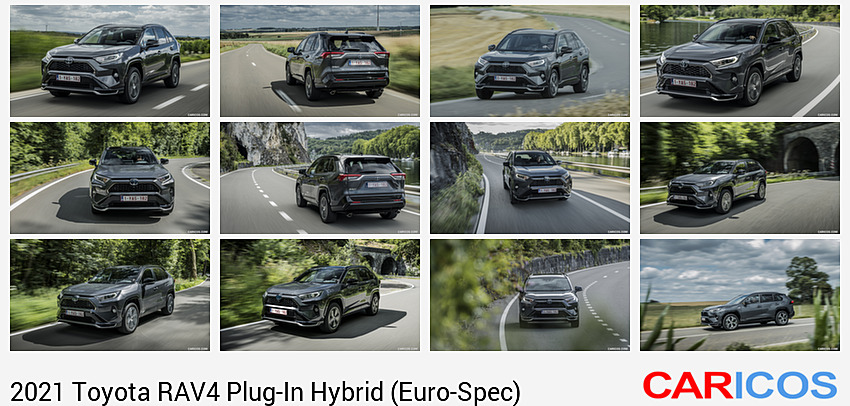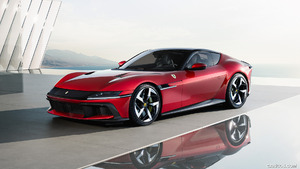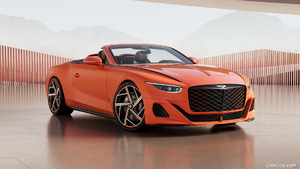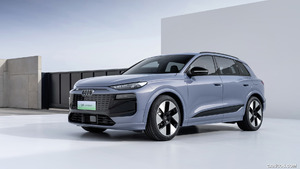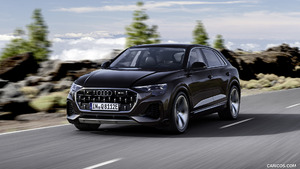2021 RAV4 Plug-In Hybrid (Euro-Spec)
- The new flagship of Toyota’s hybrid range
- The most powerful RAV4 yet, with 306 DIN hp/225 kW
- New plug-in hybrid system delivers class-leading power and efficiency
- Fuel consumption of 1.0 l/100 km and CO2 emissions of 22 g/km (WLTP)
- Driving range of up to 75 km in EV mode (WLTP) on a full battery charge
- Plug-in system also delivers all the benefits of a true Toyota Hybrid, whenever the limits of EV performance are reached
- Intelligent all-wheel drive as standard
The new RAV4 Plug-in takes its place at the pinnacle of the RAV4 range and as the flagship of Toyota’s hybrid model line-up. It is a vehicle that delivers an unmatched combination of power and environmental efficiency in its class.
Its introduction strengthens and extends the appeal of the RAV4, the model which created the market for recreational SUVs and which has amassed more than 10 million worldwide sales.
Toyota has applied its leading hybrid technology expertise to create the RAV4 Plug-in, producing a vehicle that is not only powerful, but which also outperforms all its rivals in terms of low emissions and fuel economy. The model’s final homologation data indicates 22 g/m CO2 and 1.0 l/100km (Combined WLTP cycle).
RAV4 operates as an authentic electric vehicle: EV running is its default mode, in which it can cover around up to 98 km in urban driving (City WLTP cycle) on a full battery charge, comfortably more than the average European daily commute, and reach speeds of 135 km/h, with no intervention from the hybrid powertrain.
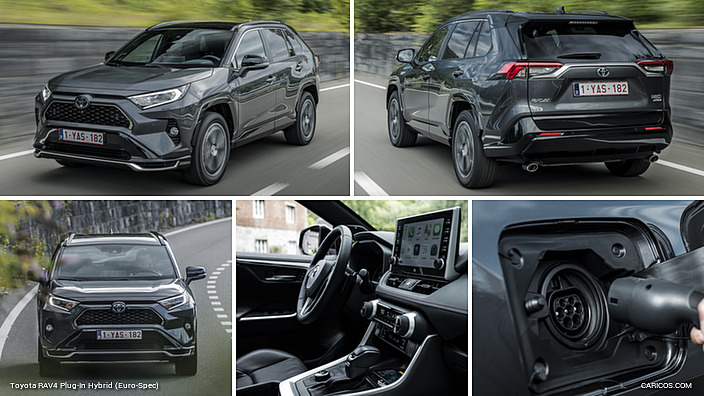 2021 Toyota RAV4 Plug-In Hybrid (Euro-Spec)
2021 Toyota RAV4 Plug-In Hybrid (Euro-Spec)
When extra engine power is needed, the capability of the 2.5-litre Dynamic Force powerplant ensures efficiency remains class-leading. Battery charging is simple and safe, and can be accomplished in 2.5 hours using a 230 V/32 A connection. As standard, owners can use the MyT app to schedule and monitor battery charging remotely and also operate the air conditioning system to warm up or cool the cabin before setting off.
Beyond its sophisticated and effective powertrain technology, the RAV4 Plug-in retains all the qualities that have made the fifth generation RAV4 so successful since its launch in late 2018. This includes the dynamic benefits of the low centre of gravity and high body rigidity inherent in the Toyota GA-K vehicle platform. It also comes as standard with AWD-i intelligent all-wheel drive.
The RAV4 Plug-in is a complementary model to the RAV4 Hybrid, consolidating Toyota’s electrification programme.
PERFORMANCE AND TECHNOLOGY
With the new RAV4 Plug-in, Toyota has created a vehicle with a dual DNA: one that has strong and genuine EV capabilities but which can also operate with highly efficient hybrid electric power.
Toyota has drawn on its experience of engineering two generations of the Prius Plug-in and has adopted an incremental approach to add extra performance to the efficiency of the plug-in technology. This has produced what is the most powerful model in the RAV4 range and one which delivers best-in-class performance in its segment in terms of EV driving range, CO2 emissions and fuel efficiency.
For the Prius Plug-in, the focus was on extending the EV driving range by using a larger high-voltage battery with the established 53 kW electric motor from the hybrid model. By contrast, RAV4 uses a more powerful motor together with a larger battery and inverter to gain significantly more drive power as well as the ability to cover much greater distances and travel at high speeds in EV mode.
Maximum output for the full powertrain, including the 2.5-litre Dynamic Force hybrid engine, is 306 DIN hp/225 kW – 38% more than the RAV4 Hybrid – enabling 0-100 km/h acceleration in 6.0 seconds – 2.1 seconds faster than the hybrid. Drivability is improved, for example with 50% more power available at 60 km/h.
In EV mode, performance is comparable to a 2.0-litre petrol model, with 0-100 km/h acceleration in 10 seconds.
2.5-litre Dynamic Force engine
The RAV4 Plug-in’s hybrid engine is a higher output version of the 2.5-litre Dynamic Force unit featured in the hybrid model, benefiting from the higher electric power to return more power and an improved torque curve.
The 2,487 cm3, four-cylinder, 16-valve DOHC Atkinson cycle powerplant features Dual VVT-i intelligent intake (electrically controlled) and exhaust valve timing and D-4S direct/indirect fuel injection with multi-hole injectors. The long, 103.4 mm stroke and the high 14.0:1 compression ratio help gain higher output and fuel efficiency. Maximum power of 185 DIN hp/136 kW is delivered at 6,000 rpm compared to RAV4 Hybrid’s 178 DIN hp/131 kW at 5,700 rpm.
The hybrid system operates an automatic warm-up phase to help protect the petrol engine against excessive wear that might occur if it is called on to make regular cold starts when the vehicle is running at motorway speeds. Power is limited, then progressively increased. The driver is alerted to the warm-up status by the engine icon showing blue in the hybrid energy flow display.
New hybrid system
The new hybrid system delivers a class-leading combination of power and efficiency. With maximum output of 306 DIN hp/225 kW, the RAV4 Plug-in is the most powerful model in the RAV4 range and Toyota’s most powerful hybrid. At the same time, its efficiency is remarkable, with significant improvements on the levels achieved by the RAV4 Hybrid.
It is also unique in its class in offering an authentic EV drive. In fact, EV mode is the default: the hybrid engine will not intervene, giving the driver the freedom to cover around 75 km (WLTP cycle) and achieve speeds of up to 135 km/h – suitable for highway driving – with zero fuel consumption and zero tailpipe emissions. And under City WLTP cycle driving, the EV range can reach 98 km.
Depending of the battery state of charge (SOC), the vehicle will automatically switch to highly efficient hybrid operation. This is a key benefit derived from basing the plug-in system on Toyota’s highly efficient hybrid technology.
Hybrid system upgrades
Toyota has developed a more powerful hybrid system for the RAV4 Plug-in, using the compact and lightweight components of the fourth generation hybrid technology featured in the RAV Hybrid, with detailed changes to optimise performance in the context of a plug-in hybrid vehicle.
There is a new lithium-ion battery, with energy capacity increased to 18.1 kWh. It contains 96 cells and has a rated voltage of 355.2 V. An increased current allows for more power: maximum output is thus significantly higher than from the unit in the RAV4 Hybrid.
The battery is located beneath the vehicle floor, which helps lower the centre of gravity and avoids intrusion in the load space or cabin. The cells are cooled using refrigerant from the vehicle’s air conditioning system, which also helps maintain the car’s EV performance.
There is a specific change to the power control unit, too. Adding a boost converter has increased the current so that more power can be drawn from the high-voltage battery. The DC-DC converter has been made smaller, quieter and more efficient, and has better cooling performance. It is positioned beneath the rear sets, taking up less cabin space.
The front electric motor produces 134 kW (compared to 88 kW in RAV4 Hybrid); the rear motor’s output is unchanged at 40 kW. With increased support from the electric motor, the hybrid engine is able to run at low revs. This contributes to the RAV4 Plug-in’s superior noise and vibration levels (further details below).
Drive modes
The RAV4 Plug-in has four different operating modes for its plug-in hybrid system:
- EV (electric vehicle) mode – the default mode
- HV (hybrid vehicle) mode
- Auto HV/EV mode
- Charging mode
It operates by default as an electric vehicle (EV), running in EV priority mode, and will continue to run purely on its electric power, even with hard use of the accelerator pedal. When the limit of EV driving range is reached in EV mode, the vehicle automatically switches to HV mode.
The driver has the flexibility of using HV mode to start their journey, switching to EV driving to maximise efficiency when necessary, for example, when entering an urban area.
In Auto EV/HV mode, the hybrid system will automatically come into play when extra power is required, for example under sharp, sudden acceleration, EV mode being restored immediately after.
Battery charging mode helps restore the level of battery charge when the level is too low for EV operation, drawing power generation by the engine.
The sequential shiftmatic system allows the driver to use the paddle shifts on the steering wheel to gain engine braking. Further assistance is provided by Deceleration Assist Control which automatically increase drive motor deceleration torque when downhill braking is detected. This makes for a smoother drive with less use of the brakes.
Acceleration performance
The power of the plug-in hybrid system delivers a strong feeling of acceleration when driving in HV mode or auto EV/HV mode. The engine’s responsiveness and the higher output from the high-voltage battery give quick performance, with nought to 100 km/h covered in just six seconds.
The control system determines whether the driver wants a smooth, linear increase in speed, or immediate, peak response. In Sport mode, the non-linear performance gives a feeling of more immediate response to increase the level of driving pleasure.
Noise, vibration and quietness
Numerous measures have been taken to reduce noise and vibration levels experienced in the cabin and achieve quiet performance from the plug-in hybrid system.
For example, the transaxle is designed so there is less resonance from the gears. The gears themselves have polished tooth surfaces for smoother and quieter operation. A damper system reduces shock and rattle on start-up, as well as fluctuations in torque in constant-speed driving.
As explained in the Performance and Technology section above, there is less noise from the hybrid engine as it can run at lower revs compared to the RAV4 Hybrid. Noise and vibration are also suppressed by additional insulation in the wing linings and front pillars and the use of acoustic glass for the windscreen and front side windows.
Air conditioning system with heat pump
The RAV4 Plug-in’s air conditioning system operates with efficiency while still ensuring cabin comfort, even when the vehicle is in EV mode.
It uses a pump that draws thermal energy from the air outside the car to heat the cabin, so running the air conditioning has less impact on the car’s EV driving range.
The system’s efficient design includes S-FLOW control which directs heating and ventilation only to seats which are occupied – driver, front passenger and the rear seats. Performance is adjusted according to the temperature selected, the ambient temperature, cabin temperature and the amount of sunlight. Power is also saved with an “off” setting for the dehumidifier, disabling the function when it would have no effect on window misting, odours or cabin comfort.
DRIVING PLEASURE
The RAV4 Plug-in’s dynamic character builds on the essential strengths of its GA-K platform by taking advantage of an even lower centre of gravity.
The platform is already notable for the low centre of gravity it secures for the RAV4 Hybrid, but thanks to the lay-out of the powertrain and, in particular, the location of the high-voltage battery beneath the floor, the centre of gravity has been lowered. This strengthens the vehicle’s handling and stability and adds to its fun-to-drive quality.
The GA-K platform also adds the benefits of light weight and high body rigidity, underpinning the RAV4’s “confident and natural” drive. It takes uneven surfaces in its stride, communicating stability, and responds naturally to the driver’s inputs.
The RAV4 Plug-in uses the same double wishbone rear suspension as the hybrid model, tuned for ride comfort. Because of the low centre of gravity and high body rigidity, the suspension does not have to be made stiffer to achieve the desired dynamic performance.
Intelligent electric all-wheel drive
All versions of the RAV4 Plug-in are equipped with AWD-i, Toyota’s intelligent electric all-wheel drive system, as featured on the RAV4 Hybrid. Compact and lightweight, AWD-i uses a 40 kW electric motor on the rear axle, giving the car the all-wheel drive performance expected of an SUV, but with superior fuel efficiency compared to a mechanical system. It operates equally when the vehicle is in its default EV mode, or when running in HV mode, with support when required from the hybrid engine.
The front/rear torque ratio is automatically optimised according to driving conditions, giving better handling and stability in slippery conditions and off-road driving, keeping the plug-in hybrid faithful to the RAV4’s essential “drive on any road” character.
Trail Mode
The RAV4 Plug-in reinforces its all-wheel drive performance with Trail Mode, an automatic locking system for the limited-slip differential that the driver can engage using a dashboard control. This ensures the best possible grip on slippery and loose surfaces and can help the driver negotiate more challenging off-road conditions. For example, if one wheel loses contact with the ground, Trail Mode will brake the spinning wheel and direct drive torque to the grounded wheel to gain traction, while also automatically adjusting the throttle response and transmission shift pattern.
Drive modes
The driver can switch between NORMAL, ECO and SPORT driving modes, adjusting throttle performance to suit their preference, or the driving conditions (SPORT mode adapts both the car’s acceleration and deceleration). This selection can be made in any of the four hybrid modes, as detailed in the Performance and Technology chapter above.
DESIGN AND PACKAGING
Toyota has ensured that the RAV4 Plug-in’s new hybrid system is packaged without compromising comfort, space and utility in both the cabin and the load compartment.
The new model shares the same external dimensions as the RAV4 Hybrid and its powertrain is designed so that it does not intrude into the cabin. There is just a small decrease in the load space capacity, with the floor being raised by 35 mm. At 520 litres, the volume remains competitive with other models in the segment.
The boot floor is flat and has an additional storage space for the charging cable beneath the deck board. The load surface remains flat when the rear seats (divided 60:40) are folded, and a flush joint with the rear finish plate makes it easy to slide heavy items into place.
With no awkward intrusions in the side of the load area, the space is practical for carrying large items. There is room for four golf bags or two 77-litre suitcases. Towing capacity is a maximum 1.5 tonnes with a braked trailer, and there is no reduction in the size of the fuel tank, its 55-litre capacity giving the vehicle an exceptional cruising range.
Exterior design
Externally, only a few small details distinguish the RAV4 Plug-in from its hybrid sibling, reflecting its “refined sports” character. There is a metal-look finish to the lower front moulding and rear garnish above the licence plate, dark chrome detailing in the headlight units and a dark plating finish for the front grille. The rear skid plate is painted black. The charging point is concealed beneath a flap on the left-hand front wing.
The RAV4 Plug-in can be fitted with larger, 19-inch wheels and larger tyres. Standard on Style grade, these have a five-double-spoke design with a contrast bright machined and black finish. The Mid grade’s 18-inch rims have a machined/dark grey five-spoke design.
The introduction of the plug-in model introduces a new body colour to the RAV4 Range, Emotional Red.
Interior design
The spacious cabin is fitted with sports seats, upholstered in dark grey cloth with contrast red stitching in the Mid grade model. The Style version has a striking two-tone red and dark grey combination of fabric and synthetic leather as standard, with the option of genuine leather with horizontal red quilting in the seatbacks and a contrast vertical red ribbon detail in the shoulder section.
The front seats have integrated heating and power adjustment and lumbar support for the driver’s seat as standard. The rear seats are also heated and the front seat ventilation and power adjustment for the front passenger seat are standard on Style+ grade.
In the combimeter in the driver’s instrument display, the water temperature indicator has been replaced with a battery level display. Specific plug-in hybrid vehicle content has also been added to the multi-information display.
In other respects, the quality and convenience of the fifth generation RAV4 is preserved, including excellent all-round vision for the driver. The GA-K platform allows for a low hip point on the driver’s seat, contributing the sense of connection with vehicle and an engaging driving experience. A generous range of seat and steering wheel adjustment makes it easy for drivers to find just the right position at the wheel.
Access to the rear seats is made easy with wide-opening rear doors and a reduced distance between the hip point and sill. Spacious footwells and air vents add to the comfort.
Equipment features
The RAV4 Plug-in introduces new equipment features and options that meet the demands of today’s customers for more sophisticated connectivity, comfort and convenience.
Notably, a 230 V/150 W power outlet is provided as standard. This can be used to power mobile devices, without having to worry about the impact on battery performance – for example running speakers for a tailgate party. Home electric appliances of 150 W or less can also be connected, for example in an emergency during a domestic power outage. There are also 12V sockets in the cabin and load space and Aux/USB sockets for connecting smartphones and music players.
Other standard features include the latest Toyota multimedia system, with smartphone integration using Apple CarPlay or Android Auto, and illuminated power switches in the door panels. The key fob includes a remote control for the vehicle’s air conditioning system, operated via the MyT app. Full details are given in the Connected Car chapter below.
The Style grade version of the RAV4 Plug-in has a nine-inch display audio mounted prominently on the centre console (an option for the Mid grade) and 19-inch alloy wheels. A colour head-up display is available for both model grades.
Toyota Safety Sense
As standard, the new RAV4 Plug-in benefits from the latest generation Toyota Safety Sense active safety and driver assistance systems. Designed to reduce the risk of some of the most common accidents, they alert the driver to hazards and, if necessary, provide braking and steering support to help avoid an impact, or reduce the severity if a collision is unavoidable.
In addition to detecting vehicles on the road ahead, the Pre-Collision System (PCS) can also recognise pedestrians in both day and night-time driving, and cyclists during daylight. The Dynamic Radar Cruise Control (DRCC) is also more sophisticated in its operation, working with the Road Sign Assist (RSA) to automatically reset vehicle speed in line with changes in the speed limit.
The combination of Lane Departure Alert and Lane Tracing Assist helps keep the RAV4 centred in its traffic lane, providing a sound alert or steering wheel vibration if it detects deviation without the turn indicators being used, then applying steering assistance if necessary to help return the vehicle to its correct path. Recognition and control performance have been improved so that assistance is also provided through gentle bends, as well as on straight highway sections. As well as lane markings on the road surface, Lane Departure Alert can also recognise road margins.
SAFE AND EFFICIENT CHARGING OPTIONS
Ease of charging is a key concern for any electric vehicle. Toyota RAV4 Plug-in provides safe and efficient options that allow a full battery recharge in just two-and-a-half hours.
The vehicle is equipped with an on-board fast-charger that can support up to 6.6 kW. without compromising the battery’s durability. As standard, it is supplied with a 7.5 m Type 2 Mode 2 cable for connection to 10 A home power supply, which enables a recharge in 7.5 hours.
The charging socket on the vehicle is located on the rear right wing with a flap that automatically locks and unlocks with the vehicle doors. The inlet has heat protection and an indicator light to show when charging is in progress and completed.
For optimum speed of recharging and safety, Toyota recommends the combination of a Type 2 Mode 3 32 A cable and a wallbox unit. With this compact, integrated set-up, recharging can be accomplished in about 2.5 hours, with no impact on the customer’s domestic power supply.
Toyota will also be making a “connected” wallbox system available that can be used by customers with different cars, identified by RFiD card recognition. The unit’s connectivity will also link to services such as billing and charging history, and enable remote software updates, via the MyT app.
The design of these Toyota products is future-proofed. They are all 22 kW units that will be able to serve vehicles introduced with more powerful on-board chargers.
A CONNECTED CAR
The RAV4 Plug-in is the first Toyota model to give the driver remote control of vehicle functions, including the air conditioning system, via the MyT customers’ app.
Toyota’s research confirms that customers choosing to buy plug-in hybrid electric vehicles expect app-based access to their vehicle, and it has made remote functions for battery management, charging and on-board comfort part of the RAV4 Plug-in’s standard specification.
Remote charging control
The owner can schedule the charging time for the vehicle, for example setting the start time to take advantage of off-peak energy tariffs.
The MyT app also allows them to check the status of the vehicle’s battery, the current driving range and the time remaining for complete charge, information that’s particularly useful when the vehicle is connected to a public charging point. Alerts can be received to warn of a low battery charge level or any problems with the charging process.
Comfort control
The new system also allows the owner to start the car’s heating or ventilation before they get behind the wheel. A defrost setting can clear screens and warm the car so no time is wasted when leaving the house; likewise, the cabin can be cooled down ready for departure on a hot day.
The system will run for up to 20 minutes, so operation can be synchronised with the time the owner wants to begin their journey.
These functions are in addition to established MyT app services, such as sending navigation destinations to the vehicle, car-to-door directions for the last part of a journey, find-my-car location; and driving analytics. Toyota will be rolling out further services in the future to increase the connected quality of its vehicles, true to its ambition to help provide mobility for all.

